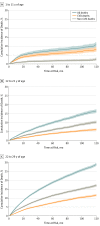Risk of Cardiovascular Disease and Mortality in Young Adults With End-stage Renal Disease: An Analysis of the US Renal Data System
- PMID: 30892557
- PMCID: PMC6484951
- DOI: 10.1001/jamacardio.2019.0375
Risk of Cardiovascular Disease and Mortality in Young Adults With End-stage Renal Disease: An Analysis of the US Renal Data System
Abstract
Importance: Cardiovascular disease (CVD) is a leading cause of death among patients with end-stage renal disease (ESRD). Young adult (ages 22-29 years) have risks for ESRD-associated CVD that may vary from other ages.
Objective: To test the hypothesis that young adult-onset ESRD is associated with higher cardiovascular (CV) hospitalizations and mortality with different characteristics than childhood-onset disease.
Design, setting, and participants: This population-based cohort study used the US Renal Data System to categorize patients who initiated ESRD care between 2003 and 2013 by age at ESRD onset (1-11, 12-21, and 22-29 years). Cardiovascular hospitalizations were identified via International Classification of Diseases, Ninth Revision discharge codes and CV mortality from the Centers for Medicare & Medicaid ESRD Death Notification Form. Patients were censored at death from non-CVD events, loss to follow-up, recovery, or survival to December 31, 2014. Adjusted proportional hazard models (95% CI) were fit to determine risk of CV hospitalization and mortality by age group. Data analysis occurred from May 2016 and December 2017.
Exposures: Onset of ESRD.
Main outcomes and measures: Cardiovascular mortality and hospitalization.
Results: A total of 33 156 patients aged 1 to 29 years were included in the study population. Young adults (aged 22-29 years) had a 1-year CV hospitalization rate of 138 (95% CI, 121-159) per 1000 patient-years. Young adults had a higher risk for CV hospitalization than children (aged 1-11 years; hazard ratio [HR], 0.41 [95% CI, 0.26-0.64]) and adolescents (aged 12-21 years; HR, 0.86 [95% CI, 0.77-0.97]). Of 4038 deaths in young adults, 1577 (39.1%) were owing to CVD. Five-year cumulative incidence of mortality in this group (7.3%) was higher than in younger patients (adolescents, 4.0%; children, 1.7%). Adjusted HRs for CV mortality were higher for young adults with all causes of ESRD than children (cystic, hereditary, and congenital conditions: HR, 0.22 [95% CI, 0.11-0.46]; P < .001; glomerulonephritis: HR, 0.21 [95% CI, 0.10-0.44]; P < .001; other conditions: HR, 0.33 [95% CI, 0.23-0.49]; P < .001). Adolescents had a lower risk for CV mortality than young adults for all causes of ESRD except glomerulonephritis (cystic, hereditary, and congenital conditions: HR, 0.45 [95% CI, 0.27-0.74]; glomerulonephritis: HR, 0.99 [95% CI, 0.76-1.11]; other: HR, 0.47 [95% CI, 0.40-0.57]). Higher risks for CV hospitalization and mortality were associated with lack of preemptive transplant compared with hemodialysis (hospital: HR, 14.24 [95% CI, 5.92-34.28]; mortality: HR, 13.64 [95% CI, 8.79-21.14]) and peritoneal dialysis [hospital: HR, 8.47 [95% CI, 3.50-20.53]; mortality: HR, 7.86 [95% CI, 4.96-12.45]). Nephrology care before ESRD was associated with lower risk for CV mortality (HR, 0.77 [95% CI, 0.70-0.85]).
Conclusions and relevance: Cardiovascular disease accounted for nearly 40% of deaths in young adults with incident ESRD in this cohort. Identified risk factors may inform development of age-appropriate ESRD strategies to improve the CV health of this population.
Conflict of interest statement
Figures


Comment in
-
Cardiovascular disease in young adults with incident ESRD.Nat Rev Nephrol. 2019 Jul;15(7):390-391. doi: 10.1038/s41581-019-0154-3. Nat Rev Nephrol. 2019. PMID: 31043718 No abstract available.
References
Publication types
MeSH terms
Grants and funding
LinkOut - more resources
Full Text Sources
Medical

